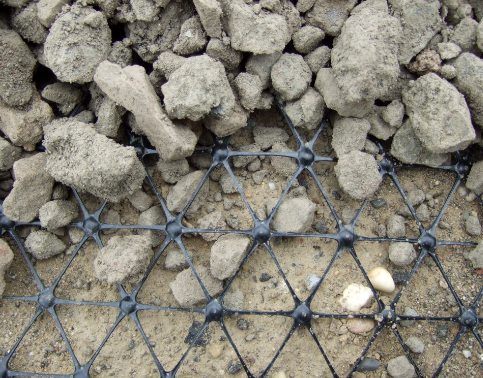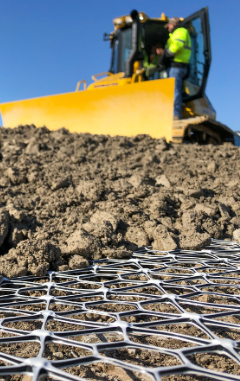- Understanding the Role of Geomembrane Liners in Waste Management
- Innovations in Geomembrane Liners for Water Management
- Geomembrane Liners: A Comprehensive Guide
- The Future of Geomembrane Liners in Civil Engineering
- Geomembrane Liners: Enhancing Landfill Stability
Manager:
WhatsApp:+86 177 0135 2670
Tel:+86 177 0135 2670
Email:marketing@okorder.com
Address:3rd Floor, No.2 Building, No.1 Sanlihe Road
Why do you need geogrid?
The use of geogrids has been on the rise in the world of civil engineering and construction. Geogrids made of plastic, fiberglass or glassfiber are essential in various infrastructural projects. These materials have a wide array of benefits that enhance the durability and safety of buildings ranging from soil reinforcement to slope stabilization. This paper examines geogrids’ importance by looking at their uses and merits as well as why they are vital in current construction practices.

Reinforcing with Plastic Geogrids
These high-density polyethylene (HDPE) or polypropylene (PP) made geosynthetics have become popular due to their high strength and ability to last long. These materials have been designed for efficient load distribution thus can be utilized in soil reinforcement applications. From road works to retaining walls, these products contribute greatly towards stability and performance of engineered structures.
Curtailing aggregate materials is one of the main objectives for using plastic geogrids. Lateral shifting is prevented through interlocking between these grids and soil particles hence the issue of deformation gets minimized while also improving load distribution. The confinement mechanism not only improves the bearing capacity of the soil but also reduces incidences such as rutting and subgrade failure more so in regions having soft soils which tend to expand.
Additionally, plastic geogrids offer cost-effective solutions for reinforcing embankments and slopes. They are light in nature making them easier to install hence reduced labor costs as well as shorter time taken during construction. Moreover, these malleable substances do not corrosive, resistant to different chemicals together with biological degradation thus guaranteeing sustainability under diverse conditions.
Exploring Wholesale Geogrids for Economical Solutions
Economically, massive consumption demands necessitated by geogrid quantities compel finding whole-sale solutions suitable for such needs. Whole-sale means purchasing in larger quantities that come with price advantages without necessarily compromising quality or performance. Geogrids for construction projects are usually bought in whole-sale as a way of enabling stakeholders to economically spend while still meeting the engineering requirements of the project.
Wholesale geogrid suppliers frequently stock different products that meet differing project specifications. If it has to be plastic and high-strength, this item is available in various selection across wholesalers’ shops in the construction industry. Furthermore, bulk purchasing allows a more efficient logistics and inventory management; thereby streamlining procurement by contractors and project managers.
Another advantage of wholesale geogrids is that they can be customized according to customer’s needs. Through working with contractors, suppliers are able to customize the specifications of geogrids depending on specific requirement of a particular project thus ensuring that cost-effective solutions are presented while achieving optimal performance. These specifications may involve changes made on aperture sizes, tensile strength or even roll sizes so as to suit versatile applications.
Enhancing Structural Integrity with Fiberglass Geogrids
Containing high-strength glass fibers, fiberglass geosynthetics have extraordinary tensile strength and stiffness making them perfect for reinforcing concrete structures as well as asphalt pavements including railway foundations. These geo-syntheses can support very heavy loads and environmental stresses thus enhancing infrastructure assets’ structural integrity and lifespan.
Effective distribution of loads within the pavement structure is one unique characteristic about fiberglass geogrids. By interlocking with asphalt layers these geo-grids reduce cracking due to reflective action hence minimizes rutting which enhances service life of parking lots/roadways over time. In addition, moisture penetration resistance plus temperature fluctuation tolerance by these fibreglass geo-synthetics mean that they maintain consistent performances irrespective of climatic differences.”
Besides, fiberglass geogrids are used to stabilize soil and reinforce slopes in addition to asphalt reinforcement. These characteristics make them particularly suited to long-term projects due to their high modulus of elasticity and low creep values. Be it the prevention of soil erosion on steep slopes or strengthening dikes along transport corridors, fiberglass geogrids are an answer for engineering questions.
The Versatility of glassfiber geogrids
Like their counterparts made from fibreglass, glassfibre geogrids have been designed for robust civil engineering reinforcement in various applications. Made up of alkali-resistant glass-fibres these grades show extraordinary tensile strength and resistance in environmental effects which makes them suitable for both soil stabilization and pavement reinforcement.
One important feature of glassfiber geogrids is that they can be combined with asphalt binders during construction thus being part of a flexible whole. In construction where new or old projects are concerned, these silica based materials improve the bond between the aggregate and bitumen leading to reduced load carrying capacity among others as well as prolonged service life without cracking under stress conditions like fatigue cycles associated with vehicular loads. Moreover, glassfiber geogrids have anti-oxidative properties that will guarantee its use even in harsh chemical environments such as those found in industries.
Apart from pavements, there are also instances whereby these materials assist in stabilizing soils through limiting aggregates while enhancing bearing capacities using fibre reinforced technologies. Therefore by reinforcing railway tracks and stabilizing embankments on riversides, this particular material offers an engineering remedy to soil erosion as well as slope slides. As such light weight also allows easy installation thereby reducing time spent during construction besides costs incurred regarding labor.

Conclusion
To sum up, the utilization of modern technologies relating to building structures could not but imply employing geosynthetics such as geogrids. Examples include plastic ones that may be used for procuring soillayers at low costs, wholesaling or substituting, among others, for fiberglass and glassfiber geogrids used in pavement and slope stabilization. This will help construction project managers to choose the right material from several types of such fabrics with unique characteristics that can be applied for different conditions."
-
2024-06-12Asphalt fiberglass geogrid construction plan
-
2024-06-04Asphalt fiberglass geogrid construction plan
-
2024-05-21What is the disadvantage of geogrid?
-
2024-05-21What is the lifespan of geogrid?
-
2024-05-21What are the 3 main uses of a geotextile?






